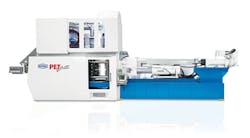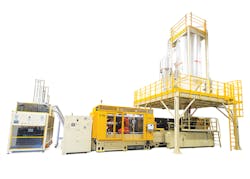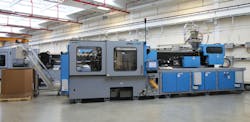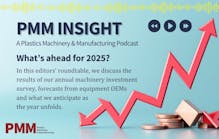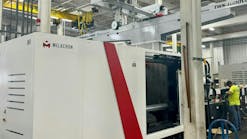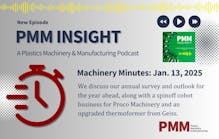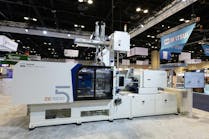Suppliers of PET preform machinery added capability to the market in the form of larger unit sizes, faster production speeds with lower energy consumption, multi-layer preforms containing a small quantity of barrier material, and a tool maintenance approach with low impact on production.
LARGE UNIT FOR PET LOVERS
Netstal-Machinery Ltd., Näfels, Switzerland, introduced the updated PET-Line 5000, its largest PET preform injection machine designed expressly for processors looking for extremely high output. The unit, designed for molds with 96 to 144 cavities, has 550 tons of clamping force. The machinery line also includes the PET-Line 4000 with 440 tons of clamping force and the PET-Line 2400 with 264 tons of clamping force.
Netstal, a member of KraussMaffei Group, Munich, revamped its PET-Line for increased operating speed coupled with energy efficiency. PET-Line models no longer operate with constant pump pressure and instead incorporate an energy-efficient adaptive drive unit with a variable controller. All of the electric drive motors on the redesigned PET-Line models are interconnected through an intermediate circuit that allows the system to recover the braking energy generated during operation. The recovered energy is used for other energy needs in the system.
The power requirement of the updated line is approximately 10 percent less when compared to the previous PET-Line design, but it achieves up to 20 percent energy savings when compared to competing models, says Reto Bamert, sales manager of the PET business unit.
In addition to the updated drive technology, Netstal updated its control technology with digital controllers combined with what it calls state-of-the-art valve technology. The control technology delivers shorter reaction times and increases oil displacement, so that oil needed to drive a particular operational movement is in position and put to work faster. A major benefit is that the open and closing movement of the mold is swifter while the dry cycle time of the machine is reduced.
Netstal also developed a part-handling robot customized for higher speed. The robot can move into the mold even when the mold is not entirely open. The lock-to-lock time—the period from unlocking the mold, removal of the preform by the robot and locking the tool for the next injection cycle—has been reduced by up to half a second with the control and drive technology updates.
The PET-Line series incorporates Netstal's DSP6 (digital signal processing) controller, which harnesses the enhanced control technology to increase the speed of the clamping unit. The technology updates equate to an increased output performance, says Bamert.
The injection and clamping units are stationed on a two-piece bed allowing users to mix and match the injection unit (three sizes per model available) and the clamping unit (three sizes per model offered) to the output rates desired. PET-Line is comprised of an electric screw drive and energy adapter drive for plasticizing, with servo-driven hydraulics governing injection and clamping. A high cavitation tool running on an updated PET-Line press can produce 2 million PET preforms daily.
SINGLE SOURCE
FOR PREFORMS
Milacron LLC's Plastics Machinery Americas, Batavia, Ohio, re-entered the PET preform molding machine market with the introduction of its new M-300 PET preform system. This servo-hydraulic model is designed entirely from components made by divisions of Milacron LLC, Cincinnati, and includes the machine, hot runner, mold, robot and end-of-arm tooling.
Milacron says close-coupled integration of its technology in the manufacturing of this machine delivers unparalleled production performance with energy efficiency. The machine and post-mold cooling is almost entirely driven by servo motors, with hydraulics used only for ejection and injection.
The system is designed to use molds with up to 128 cavities and can produce PET preforms with standard neck finishes at a rate of 80,000 units per hour. The product line will consist of three clamping units and five injection units, including the M-PET 150, which handles up to 48 cavities, and the M-PET 500, which can handle up to 144 cavities. New and existing PET preform tooling from Milacron and tools from other vendors can be used on the machine.
The M-PET 300 machine at the show featured a two-stage injection unit comprised of separate extrusion (for plasticizing) and injection functions. Milacron's PET Star screw design helps keep acetaldehyde generation low while minimizing the residence time of the material. Milacron's new Mosaic+ control provides closed-loop fill-velocity control and closed-loop pack-pressure control for precise shot-to-shot injection.
Clamping is based on a Ferromatik all-electric, five-point toggle with a rigid three-platen design that evenly distributes clamping forces and can reduce tonnage requirements. Linear bearings directly on the machine base support the moving platen. Other features include an integrated pneumatic hot-runner valve-gate control, closed-loop mold stroke, tonnage and ejector stroke control.
New tooling from Milacron for use with M-PET features Milacron's Cool Box integrated post-mold cooling system that provides enhanced/extended cooling without a cycle-time penalty. At NPE, Milacron's M-PET 300, which delivers 300 tons of clamp force, produced 10.2 gram PET preforms made in a 72-cavity tool during a less than seven-second cycle. It was outfitted with the new Mosaic+ control. The mold provided 18 seconds of cooling. The overall energy signature of the molding cell is approximately 0.13 kilowatts per hour per kilogram of material processed.
THIS PET PREFORM UNIT
SELF CLEANS, ADDS BARRIER MODULE
Husky Injection Molding Systems Ltd., Bolton, Ontario, showcased its HyPET HPP5 hybrid PET preform molding system to demonstrate a new fully automated self-cleaning feature for the tool designed to trim the maintenance time for the task from hours to as little as eight seconds.
The new mold feature is integrated into the architecture of Husky's Polaris control as part of the company's reduced maintenance package for the HyPET HPP5 system. Buildup of dust in the mold vents during production typically requires a processor to halt production before sending a maintenance technician into the machine for cleaning. Now, the self-cleaning operation is a program step integrated into the machine controls that interrupts the molding cycle temporarily.
The self-cleaning program starts with a push of a button on the control panel. Specially designed over-flow channels in the tooling open and the machine goes through the injection cycle, shooting material in the mold cavities in a controlled flash step. In essence, the machine molds bad parts containing the flashed material in every cavity for one molding cycle. The mold opens and the stripper plate executes a double push to eject the bad preforms. The molding cell is set up in such a way that the bad preforms fall into a bin beneath the machine.
The self-cleaning step eliminates the need for production to stop and for a technician to climb into the press. When the self-cleaning cycle is complete, the system closes the overflow cavity and resumes commercial production.
Nicolas Rivolett, Husky's director of business development, says the self-cleaning step can cut up to 400 hours of maintenance time a year while extending the interval between cleaning and greasing to every 500,000 cycles. The reduced maintenance results in a productivity gain of about 5 percent.
Husky also demonstrated its enhanced mold alignment technology on the HyPET HPP5 unit. The alignment technology is a real-time 3-D measurement of the mold alignment, displayed as a constant feedback signal on the system's human machine interface. As many as six sensors are placed on the mold to detect the position of the core plate with respect to the cavity plate. If misalignment occurs, the operator can correct it by turning a positioning device, which is accurate to a few microns, says Rivolett.
Husky also introduced a new module that allows for the production of multi-layer barrier PET preforms on the HyPET HPP5 machine. Processors can create PET preforms with low barrier content—containing either 1 percent or 2.5 percent barrier material—which can save as much as 50 percent on barrier material costs. The multi-layer barrier module is compatible with mono-layer and multi-layer tooling and uses Husky's Stratus hot-runner technology to precisely dose and distribute the barrier material and balance the delivery of the melt streams.
TWO CONFIGURATIONS FROM ONE SOURCE
Sipa SpA, Vittorio Veneto, Italy, displayed its horizontal two-platen Xform series injection press. The blow molding machinery supplier partnered with Athena Automation Ltd., Vaughan, Ontario, several years ago to offer customers PET preform systems that handle molds with up to 96 cavities. Sipa is represented in North America by Sipa North America Inc., Atlanta.
The Xform 150 and 300 are offered with a hydraulically driven reciprocating screw injection unit or a two-stage extruder and plunger unit featuring an electrically driven extruder with a shooting pot. The platen is electrically driven.
Sipa manages the sales and integration of all Athena machines configured for PET preform production on an exclusive, worldwide basis.
The injection machine models for preform molding include the Xform 150 with 169 tons of clamp force, capable of handling molds with up to 48 cavities, and the Xform 300 with 337 tons of clamp force and the ability to handle tools with as many as 96 cavities.
Mikell Knights, senior correspondent
Contact:
Athena Automation Ltd., 905-265-0277, www.athenaautomation.comHusky Injection Molding Systems Ltd.,905-951-5000, www.husky.co/en-usKrauss Maffei Corp., 859-283-0200, www.kraussmaffeigroup.us/en/Milacron LLC, 513-536-2000, www.milacron.comSipa North America Inc., 404-349-3966, www.sipa.it
